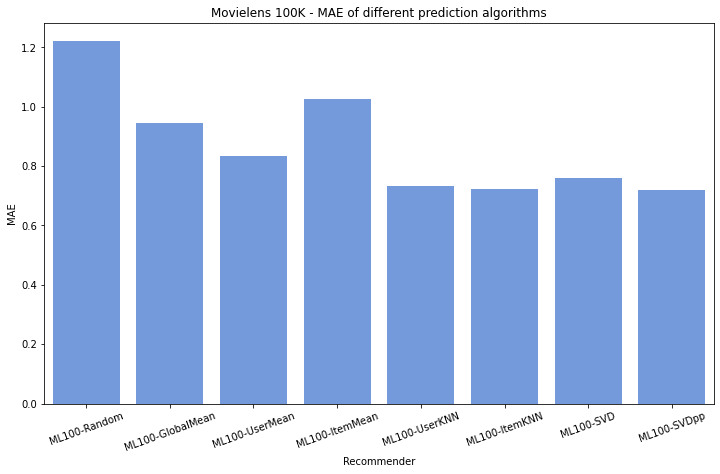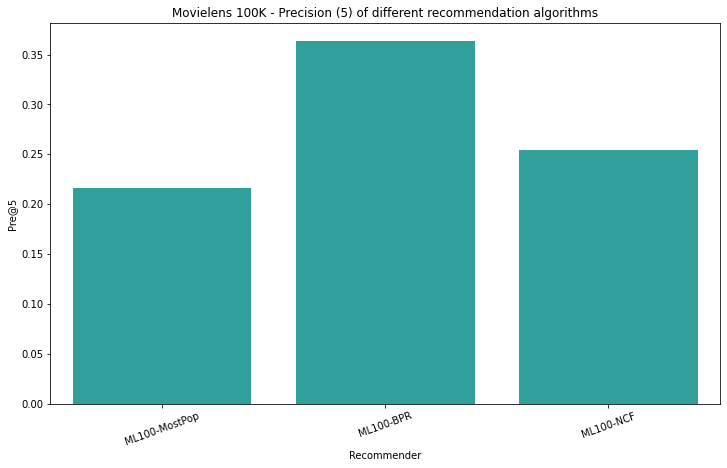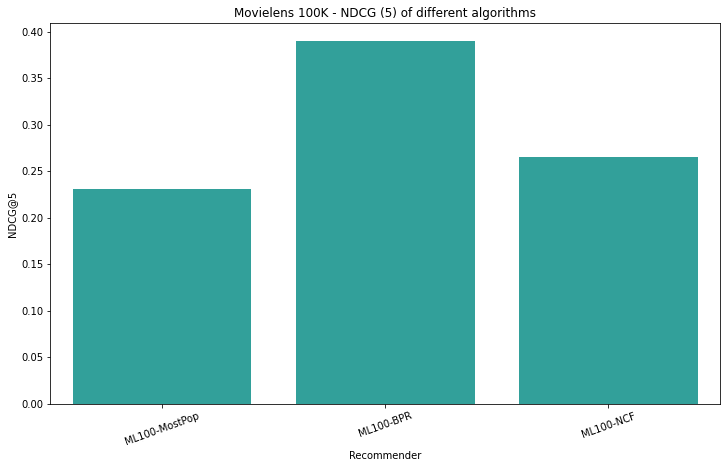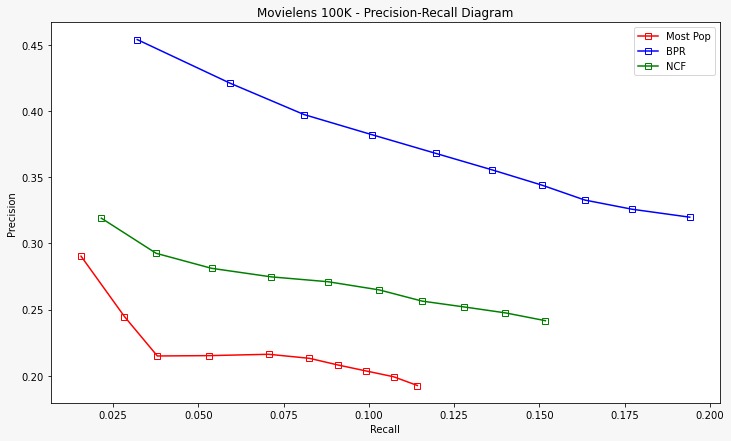Implementations and evaluations of various recommender system algorithms from the literature
- Various Recommenders:
There are 3 main directories:
- implementations_from_scratch: In here you can find our from-scratch implementations of some of the algorithms that we used. It was useful for us to see and understand how the algorithms and recommendation techniques worked on a low level before moving on to using various libraries. The varous implementations include two KNN collaborative filtering algorithms (user and item based), an implementation of Matrix Factorization, Neural Collaborative Filtering and BPR based on Keras:
- notebooks: This directory contains the code divided by the category of the algorithms that we have used in this project. In each notebook there is a detailed implementation along with evaluation and most importantly Grid Search for the bigger models:
- Basic-Algorithms: Code for Random Predictios, User, Item and Global Mean Predictors using Surprise
- Bayesian-Personalized-Ranking: Implementation of BPR using Cornac
- KNNCF-Prediction: Code for KNN Collaborative Filtering algorithms, used for Rating Prediction. Implemented using Surprise
- KNNCF-Recommendations: Code for KNN Collaborative Filtering algorithms, used for Item Recommendation. Implemented using Surprise
- Bayesian-Personalized-Ranking: Implementation of NCF/NeuMF using Cornac
- SVD: Implementation of SVD, a Matrix Factorization algorithms. Contains also code for SVD++. Implemented using Surprise
- final_notebooks: This directory contains three notebooks, one is just to create the charts you can see in the images section and the other two contain the code for running all the different models, based on the task they were created for.
- Rating-Prediction: In this notebook you can run and experiment with all the Rating Prediction algorithms. The notebook generates a results table in the end which you can use to see how the various models perform and compare them to one-another.
- KNN-Item-Recommendation-Surprise: In this notebook you can run and experiment with all KNN Top-N Recommender algorithms. The notebook generates a results table in the end which you can use to see how the various models perform and compare them to one-another.
- Item-Recommendation_Cornac: In this notebook you can run and experiment with all the Item Recommendation except KNN Recommenders algorithms. The notebook generates a results table in the end which you can use to see how the various models perform and compare them to one-another. For our final implementations with we also decided to power up Cornac with the very hand Microsoft Recommender Utilities.
The code inside the notebooks is well documented and understandable. The use of libraries allowed us to perform the evaluation procedures in the same place for the different classes of algorithms (with the exception of the KNNCF for Item Recommendation which is not implemented and evaluated with Cornac unlike the other Item Recommendation models).
This project uses the famous Movielens100K dataset, denoted as ML100. You can download it here or just use the u.data file that is located inside the data directory Below follow the results of this project.
| Recommender | RMSE | MAE | LibRec RMSE | LibRec MAE |
|---|---|---|---|---|
| ML100-Random | 1.527 | 1.228 | - | - |
| ML100-GlobalMean | 1.126 | 0.945 | 1.126 | 0.945 |
| ML100-UserMean | 1.042 | 0.835 | 1.042 | 0.835 |
| ML100-ItemMean | 1.283 | 1.040 | 1.025 | 0.817 |
| ML100-UserKNN | 0.939 | 0.733 | 0.944 | 0.737 |
| ML100-ItemKNN | 0.922 | 0.721 | 0.924 | 0.723 |
| ML100-SVD | 0.959 | 0.761 | 0.936 | 0.730 |
| ML100-SVDpp | 0.924 | 0.720 | 0.912 | 0.718 |
| Recommender | Pre@5 | Pre@10 | Rec@5 | Rec@10 | NDCG@5 | NDCG@10 |
|---|---|---|---|---|---|---|
| ML100-UserKNN | 0.335922 | 0.342011 | 0.308369 | 0.454819 | 0.514365 | 0.448701 |
| ML100-ItemKNN | 0.331019 | 0.376929 | 0.298958 | 0.495591 | 0.415851 | 0.376731 |
| Recommender | Pre@5 | Pre@10 | Rec@5 | Rec@10 | NDCG@5 | NDCG@10 |
|---|---|---|---|---|---|---|
| ML100-MostPop | 0.21617 | 0.192553 | 0.0706593 | 0.114259 | 0.2305 | 0.220767 |
| ML100-BPR | 0.363362 | 0.309915 | 0.12789 | 0.209184 | 0.389562 | 0.369578 |
| ML100-NCF | 0.254 | 0.235766 | 0.0844287 | 0.149687 | 0.265001 | 0.266357 |
-
As it can be seen from the tables above the rating prediction task was successful. The implementations here worked well and by tweaking the libraries we obtained great results. The Item recommendation task has also produced relatively good results. We managed to drop down the precision and recall to the norms using our own evaluation metrics and Surprise for the model.
-
We can see a clear trend in the third table regarding Top-N reccomendations. BPR is clearly the best model and that is what we expect, followed by NCF and then the Most Popular baseline. This is on par with the LibRec evaluation. Please do note that the second and third table have been evaluated slightly differently, hence the difference in the Recall and NDCG. We are using two different libraries and that is why we separated the tables. The lower than ususal NDCG and Recall attributes in the third table are results of the Cornac evaluation policy. You can check out this issue in their official repository to better understand. When looking at KNN algorithms with Cornac we got very very low results so we decided to use a variation with Surprise also for the item recommendation task.
To see the various Grid Search runs you can check out the single algorithm implementations in the notebooks directory. When single-handidly studying the algorithms we performed Grid search for hyperparameter tuning on most of them, while also running cross validation afterwards.
- Graph-based implementations: It would be a great to also try and implement collaborative filtering using graph implementations. We know that we can also compute collaborative filtering exercises using graph methods and that would be a great way to display the power of graph implementations.
- Statistical significance testing: Even though we have used 5-fold cross validation for all the evaluation and the data does not vary by a lot (means of both datasets are very similar) the results we are getting are probably significant, but still the only way to formally make sure of this is by doing a statistical test. An example of that would be a t-test or even pairwise t-tests to compare the results between models.




